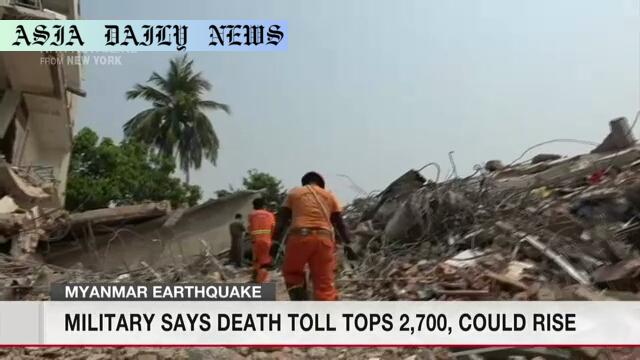earthquake – The death toll from a magnitude 7.7 earthquake in central Myanmar exceeds 2,700, with warnings of rising casualties.

Catastrophic Earthquake Strikes Central Myanmar
The 7.7 magnitude earthquake that shook central Myanmar has become one of the deadliest natural disasters in the region’s recent history. With an already staggering death toll of 2,719 and over 4,500 injured, the tragedy continues to unfold as rescue operations face considerable challenges. Reports indicate that 441 people remain unaccounted for, and the numbers are expected to rise as more regions report damages and casualties.
The wide extent of destruction has hampered search and rescue operations, with many areas proving difficult to access. While teams work tirelessly to recover survivors and uncover bodies trapped under rubble, the sheer magnitude of damage to housing facilities and infrastructure further complicates efforts. In one glimmer of hope, rescue workers pulled a 63-year-old woman alive from debris after a grueling 90-hour entrapment in the capital of Naypyitaw.
Bangkok Suffers a Secondary Catastrophe
The earthquake’s tremors were felt far beyond Myanmar, wreaking havoc in Bangkok, Thailand. A high-rise building under construction collapsed, killing at least 13 individuals. With over 70 people still missing, local authorities are scrambling to assess the scale of the disaster. Investigations revealed that substandard steel rods used in the building contributed to the collapse, raising concerns about construction quality in highly seismic areas.
The Thai government, responding to fears of aftershocks and additional damages, has formed a special committee to probe into the disaster. They have also reached out to Japan for assistance, leveraging Japanese expertise in earthquake-resistant construction and disaster management practices. Over 10,000 buildings in Bangkok alone suffered damage, and residents are growing increasingly anxious about structural safety in the quake’s aftermath.
Ongoing Risks and Lessons to Be Learned
As the aftershock risks persist, there is an urgent need for stronger disaster preparation and response mechanisms in earthquake-prone areas. The tragedy uncovered numerous faults in urban planning, construction standards, and emergency preparedness. Experts stress the importance of employing modern earthquake-resistant technologies and stricter building regulations, particularly in densely populated regions like Bangkok.
The emotional toll is also monumental. Survivors, many of whom have lost homes and loved ones, are grappling with trauma and uncertainty about the future. Relief agencies and governments must focus not only on immediate rescue and recovery but also on long-term rebuilding with a stronger emphasis on disaster resilience.
Moving forward, regional cooperation and shared expertise will be essential in mitigating the impact of similar tragedies. Myanmar and Thailand’s respective actions could become critical case studies in developing better disaster response frameworks for Southeast Asia as a whole.
Commentary
The Devastating Impact of Natural Disasters
The earthquake in Myanmar and its spillover effects in Thailand serve as a stark reminder of nature’s overwhelming power. With over 2,700 lives lost and many more injured or missing, the human cost of this disaster is difficult to comprehend. It is heartbreaking to witness entire communities being reduced to rubble, where the rescue of even one survivor becomes a monumental achievement. The rescue of the 63-year-old woman after 90 hours exemplifies human resilience and determination amidst despair.
However, this tragedy also highlights the weaknesses in our preparedness for such events. In Myanmar, the widespread destruction has slowed rescue efforts to a crawl. By investing in better infrastructure and training for emergency responders, such barriers could potentially be reduced in the future. Thailand, too, has been forced to confront the consequences of poor construction practices. The high-rise collapse in Bangkok underscores a critical need to enforce stricter building regulations and inspections. Loss of life due to avoidable failures only compounds the suffering brought by natural disasters.
Stronger Regional and International Cooperation Needed
One positive development in the wake of this tragedy is Thailand’s decision to seek help from Japan. As a country well-versed in earthquake-resistant architecture and disaster management, Japan’s involvement could pave the way for significant improvements in Southeast Asia’s disaster resilience. Regional cooperation should become a cornerstone of disaster preparedness, with knowledge-sharing initiatives extending beyond immediate recovery efforts.
Meanwhile, governments should prioritize reassuring and supporting their citizens. The fear of aftershocks has left many residents living in uncertainty, reluctant to return home or occupy damaged buildings. Mitigating such anxieties will require clear communication, swift inspections, and structural reinforcements where needed.
Looking Ahead with Solutions
The path forward lies in viewing this disaster as an opportunity to build stronger, safer communities. Policymakers must tighten regulations, empower local authorities with resources, and engage with international partners to create sustainable solutions. Survivors, too, will need mental health and financial support to rebuild their lives in the face of immense personal loss.
In sum, this earthquake is not just a tragedy but a call to action. It is a reminder that while natural forces may be unpredictable, the world’s response to them need not be. With better planning, collaboration, and compassion, the impact of future calamities can be mitigated, ultimately saving countless lives.


